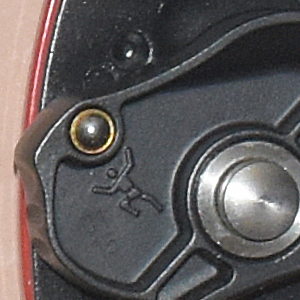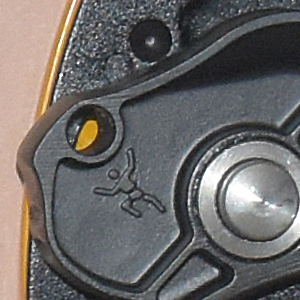Technical Details
Miles Bradshaw helped me get this from U.K. eBay seller vienna3178 in 2023.
My Anthron Lory is 125 mm. tall, 71 mm. wide, 36 mm. thick, and weighs 365 g.
The Anthron Lory is a shaped like a flattened and deformed avocado.
The Anthron Lory consists of four major components: the body, the rotating
cam, a cover plate, and an actuating lever assembly.
The body and
cover plate are forged from aluminum. Superficially,
they are mirror images of each other, although there are some
details where this symmetry breaks down. In other, more practical
words, the front cover and rear body are roughly the same thickness,
and the seam between the two splits the closed device in half.
A 6.4 mm. stainless steel rivet joins the front and back
near the top. Each piece has a cast stainless steel insert, and the inserts
are shaped so that with the covers closed, the inserts form a
groove for 10 mm. diameter rope.
The cam assembly pivots
on a roughly 15 mm. stainless steel axle attached to the body.
The attachment method is not clearly visible. A spring-loaded
button protruding from the cam axle passes through a hole in the
front plate when the cover is closed.
The bottom of the body and
cover have aligned 18 mm. holes that form the attachment
point. The body has a cast stainless steel anvil next to the hole. The anvil
has a U-shaped groove for the rope to run over. The anvil and
lever assembly are held by a 5 mm. stainless steel rivet.
The rotating cam is cast steel. It has a webbed design with
several reinforcing ribs. The right side of the cam has a rounded
V-shaped rope channel with about a 6 mm. minor diameter at the
base of the V. The left side has two small grooves to provide
a finger grip for feeding rope. The bottom of the cam has a flat
area that squeezes the rope against the lower anvil when the cam
rotates counter-clockwise (i.e., when it closes).
The lever assembly consists of a control lever connected
to the cam by a steel link. Pulling the lever downward forces
the link upward, opening the cam; however, once the lever passes
a certain point, the link disengages and the cam rotates closed
again under rope tension. At this point, raising the lever opens
the cam; but again, the action stops if the lever moves too far.
The cover is printed with "Lory," "CE0123,"
a drawing of the rope path with an anchor icon at the top and
a hand icon at the bottom, "ANTHRON," the Anthron logo, a book-with-an-"i" icon, "2313-038, a double ended arrow with "press" at one end and "&push" at the other (i.e., opening instructions), "EN341-A," "EN353-2," "EN358," "EN15151–C," "10≤•≤11," and "www.anthron.si." The cam has a raised climber icon.
The lower anvil has a molded hand-holding-a-rope icon.
The Anthron Lory is one of the following closely-related devices:
The Slovenian company Anthron made the Anthron Lory, Bornack Lory, Edelrid Eddy, Rollgliss R250, and Singing Rock Sir. The German firm Skylotec bought Anthron in 2016 and continued production with the Skylotec Lory and Lory Pro.
Some of these were sold as belay devices, and the others as descenders. The belay device and descender versions are not the same. The difference is subtle, and easily overlooked. The belay versions have a double-ended plunger pressed into the cam. The cam can be aligned so that spring-loaded balls rest in detents in the body and cover plates, lightly holding the cam in a position that allows relatively free motion of a slack rope.
| Belay Cam |
Descender Cam |
 |
 |
One would think that any of these could be used for either purpose, but Skylotec warns against this. They certified their Lory and Lory Pro to different standards. The lawyers have spoken, and I will not openly disagree (in the U.S.A., it is unwise to disagree with lawyers). Having tried both, I can say that the belay cam seems only slightly easier to use when belaying. With either cam, I could feed rope out easily by manually lifting the cam with an index finger. Taking rope in was even easier - I just pulled it through the device. I didn't notice any difference between the two cams when rappelling: rope tension easily overpowers the spring-loaded balls.
The Anthron Lory has excellent workmanship and it functions well. It
is solid, but it is also quite heavy. This should not be a problem
for gym climbers or people who drive to the base of short sport
climbs, but I wouldn't consider lugging one of these to a remote climb
or up a wall.
The lever function provides partial backup for the user not knowing how to use the lever, but like all such devices, it relies on the user being completely incompetent rather than partially incompetent.
The lever action has a bizarre feature: once the user
moves the lever past the release point, the lever function reverses.
In other words, I would normally lower by pulling down
on the lever, with farther down meaning a faster lower. If I pull
too far, then the cam locks. At this point, I could resume lowering
by pushing the lever up, with farther up meaning a faster lower.
If I go to far again, the action reverses a second time, and the
lever operates as it originally did. I do not like this behavior. I found that if I somehow pull the handle into the lower lock position, I could "slam" the handle upward to the upper locking position with a negligible drop, bypassing the reverse-acting behavior. Sort this out at home, not
at the cliffs. I give this feature a lemon award:  .
.
The lever assembly is greased. This grease will pick up sand
and dirt. As an enclosed device, the Anthron Lory is not well-suited for use on severely mud-covered ropes.


